|
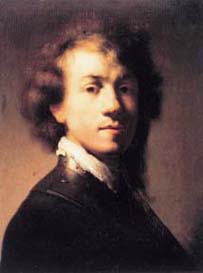 |
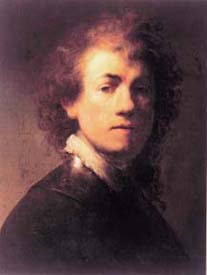 |
|
Self-Portrait in a Gorget, ca. 1628, 37.9 x 28.9 cm (10 cm=1 in), The Hague |
ca. 1630, 38.2 x 31 cm (10 cm=1 in), Nuremberg |
|
 |
 |
|
Self-Portrait in a Gorget, ca. 1628, 37.9 x 28.9 cm (10 cm=1 in), The Hague |
ca. 1630, 38.2 x 31 cm (10 cm=1 in), Nuremberg |
![]() One of the
most vivid illustrations of the current predicament of Rembrandt scholarship is
the exhibition "Rembrandt by Himself," which was recently on view in London and
The Hague. The show was directly connected with the Rembrandt Research Project,
whose members provided essays for the catalogues and whose (revised) conclusions
are adopted in the catalogue entries. In my opinion, the majority of the
exhibited "self-portraits" are not by Rembrandt, but rather variations on
self-portraits by Rembrandt or portraits of Rembrandt by his students.
One of the
most vivid illustrations of the current predicament of Rembrandt scholarship is
the exhibition "Rembrandt by Himself," which was recently on view in London and
The Hague. The show was directly connected with the Rembrandt Research Project,
whose members provided essays for the catalogues and whose (revised) conclusions
are adopted in the catalogue entries. In my opinion, the majority of the
exhibited "self-portraits" are not by Rembrandt, but rather variations on
self-portraits by Rembrandt or portraits of Rembrandt by his students.
![]() There are
already indications within the show that things are more complicated than they
seem. The most significant example involves one of Rembrandt's most famous
paintings, his self-portrait as a young man wearing a military gorget, from the
Mauritshuis museum in The Hague (Fig. 1). The curators claim to have proved
definitively that this is a copy by a student after Rembrandt's original in the
Nationalmuseum of Nuremberg (Fig. 2), previously assumed to be a copy after the
original in The Hague.1
This is a radical claim, and either bravely honest or rashly self-deceiving,
since the Mauritshuis wa one of the co-sponsors of the exhibition. More
specifically, either Rembrandt scholarship has been mistaken all this time and
has applied the wrong criteria for determining Rembrandt's autograph works or
the current curators are mistaken and apply the wrong criteria. The stakes are
particularly high, since to my knowledge all commentators have adopted the
"rehabilitation" of the copy as Rembrandt's original. In my opinion, the
curators are mistaken, yet their error was only possible because the existing
criteria are not clear enough, so that all works attributed to Rembrandt should
be subject to question.
There are
already indications within the show that things are more complicated than they
seem. The most significant example involves one of Rembrandt's most famous
paintings, his self-portrait as a young man wearing a military gorget, from the
Mauritshuis museum in The Hague (Fig. 1). The curators claim to have proved
definitively that this is a copy by a student after Rembrandt's original in the
Nationalmuseum of Nuremberg (Fig. 2), previously assumed to be a copy after the
original in The Hague.1
This is a radical claim, and either bravely honest or rashly self-deceiving,
since the Mauritshuis wa one of the co-sponsors of the exhibition. More
specifically, either Rembrandt scholarship has been mistaken all this time and
has applied the wrong criteria for determining Rembrandt's autograph works or
the current curators are mistaken and apply the wrong criteria. The stakes are
particularly high, since to my knowledge all commentators have adopted the
"rehabilitation" of the copy as Rembrandt's original. In my opinion, the
curators are mistaken, yet their error was only possible because the existing
criteria are not clear enough, so that all works attributed to Rembrandt should
be subject to question.
![]() But let us
first examine the arguments regarding the two "self-portraits." Technical
examination of the Hague painting in 1998 revealed an under-drawing of charcoal
or black chalk (Fig. 1a). The curators note that such a strategy is
unprecedented in Rembrandt's work. They also claim that the positions of the
eyes and hairline in the under-drawing correspond exactly to the Nuremberg
painting and therefore conclude that the author of the Hague painting copied the
Nuremberg painting in his under-drawing and later changed the composition in his
painting. The curators observe further that "the meticulous painting technique
of the Hague panel contrasts with the ease and spontaneity of the Nuremberg
piece." They associate the latter approach with Rembrandt and the former with
the student-copyist, specifically Rembrandt's first student Gerrit Dou, who is
therefore put forward as the author of the Hague painting. The boundaries in the
Hague composition furthermore "seem unnatural in places," "the reflection on the
left of the lower lip is not quite right," and "the somewhat elongated face and
close-set eyes diminish the resemblance to Rembrandt's features."2
But let us
first examine the arguments regarding the two "self-portraits." Technical
examination of the Hague painting in 1998 revealed an under-drawing of charcoal
or black chalk (Fig. 1a). The curators note that such a strategy is
unprecedented in Rembrandt's work. They also claim that the positions of the
eyes and hairline in the under-drawing correspond exactly to the Nuremberg
painting and therefore conclude that the author of the Hague painting copied the
Nuremberg painting in his under-drawing and later changed the composition in his
painting. The curators observe further that "the meticulous painting technique
of the Hague panel contrasts with the ease and spontaneity of the Nuremberg
piece." They associate the latter approach with Rembrandt and the former with
the student-copyist, specifically Rembrandt's first student Gerrit Dou, who is
therefore put forward as the author of the Hague painting. The boundaries in the
Hague composition furthermore "seem unnatural in places," "the reflection on the
left of the lower lip is not quite right," and "the somewhat elongated face and
close-set eyes diminish the resemblance to Rembrandt's features."2
 |
 |
 |
|
Self-Portrait in a Gorget, ca. 1628, 37.9 x 28.9 cm (10 cm=1 in), The Hague |
(10 cm=1 in). |
ca. 1630, 38.2 x 31 cm (10 cm=1 in), Nuremberg |
![]() The relation
described by the curators is exactly the opposite of what can be expected of a
copyist following his master's example. It would be particularly odd for a
copyist to follow his master's composition in an under-drawing, and then to
elaborate freely on this in his painted composition. In fact, there are already
changes in the under-drawing, as noted by the curators: "the contours of the
gorget and torso have been drawn several times over, revealing an effort to find
the correct position for these elements."3
These changes correspond to pentimenti in the Hague painting revealed by X-rays,
which are not discussed in the catalogue of the self-portrait exhibition. The
pentimenti were noted in the corpus of the Rembrandt Research Project where,
partly for this reason, the painting was identified as the original and the
Nuremberg version, which has no under-drawing or pentimenti, as the copy. But
what about the correspondence between the under-drawing and the Nuremberg
version? As with the ostensible weaknesses of the Hague painting or its lack of
resemblance to Rembrandt, this is in my opinion simply a projection (or
delusion) of the curators. The under-drawing, illustrated through a computer
montage of infa-red reflectographs, is included in their catalogue on a separate
page. When they are placed next to one another, the underdrawing makes perfect
sense as the first step in the genesis of the Hague painting, whereas there is
no evident correspondence to the Nuremberg painting (Figs. 1, 1a, 2).
The relation
described by the curators is exactly the opposite of what can be expected of a
copyist following his master's example. It would be particularly odd for a
copyist to follow his master's composition in an under-drawing, and then to
elaborate freely on this in his painted composition. In fact, there are already
changes in the under-drawing, as noted by the curators: "the contours of the
gorget and torso have been drawn several times over, revealing an effort to find
the correct position for these elements."3
These changes correspond to pentimenti in the Hague painting revealed by X-rays,
which are not discussed in the catalogue of the self-portrait exhibition. The
pentimenti were noted in the corpus of the Rembrandt Research Project where,
partly for this reason, the painting was identified as the original and the
Nuremberg version, which has no under-drawing or pentimenti, as the copy. But
what about the correspondence between the under-drawing and the Nuremberg
version? As with the ostensible weaknesses of the Hague painting or its lack of
resemblance to Rembrandt, this is in my opinion simply a projection (or
delusion) of the curators. The under-drawing, illustrated through a computer
montage of infa-red reflectographs, is included in their catalogue on a separate
page. When they are placed next to one another, the underdrawing makes perfect
sense as the first step in the genesis of the Hague painting, whereas there is
no evident correspondence to the Nuremberg painting (Figs. 1, 1a, 2).
![]() The
under-drawing furthermore corresponds to Rembrandt's self-portrait drawing in
the British museum, executed in pen and brown ink and brush and gray wash (Fig.
3). In each case we find the individual strands of thinner hair at the upper
left side of his face and across his forehead, as opposed to the thicker bunches
of curls behind. In both the drawing and the painting, the shadow cast across
the right side of the face marks a strong contour, tracing along the pointed
chin, the ridges below the nose, and along the right eye socket, whereas some
light falls on the right cheek and right eye, staring out at us from the shadow.
The British museum drawing was included in the exhibition, where the curators
note a resemblance to the Nuremberg painting and posit a connection with other
ostensible Rembrandt self-portraits. They admit in a note that "it is
conceivable that the maker of the Hague painting used this drawing as a second
example" together with Nuremberg painting.4
It is far more logical to recognize the drawing as preparatory study, developed
further in the under-drawing and the painting in The Hague. The fact that
under-drawings are unprecedented in Rembrandt's work is less of a problem given
that the example in the Hague painting was only discovered last year. There
could be other examples. Conversely, this could be a singular example related to
Rembrandt's evolving practice, just as the British Museum drawing is in my
opinion his only preparatory study for a painted self-portrait.
The
under-drawing furthermore corresponds to Rembrandt's self-portrait drawing in
the British museum, executed in pen and brown ink and brush and gray wash (Fig.
3). In each case we find the individual strands of thinner hair at the upper
left side of his face and across his forehead, as opposed to the thicker bunches
of curls behind. In both the drawing and the painting, the shadow cast across
the right side of the face marks a strong contour, tracing along the pointed
chin, the ridges below the nose, and along the right eye socket, whereas some
light falls on the right cheek and right eye, staring out at us from the shadow.
The British museum drawing was included in the exhibition, where the curators
note a resemblance to the Nuremberg painting and posit a connection with other
ostensible Rembrandt self-portraits. They admit in a note that "it is
conceivable that the maker of the Hague painting used this drawing as a second
example" together with Nuremberg painting.4
It is far more logical to recognize the drawing as preparatory study, developed
further in the under-drawing and the painting in The Hague. The fact that
under-drawings are unprecedented in Rembrandt's work is less of a problem given
that the example in the Hague painting was only discovered last year. There
could be other examples. Conversely, this could be a singular example related to
Rembrandt's evolving practice, just as the British Museum drawing is in my
opinion his only preparatory study for a painted self-portrait.
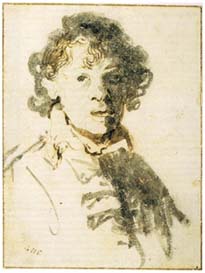 |
 |
 |
 |
|
127x95cm (not to scale), London |
(10 cm=1 in). |
Self-Portrait in a Gorget, ca. 1628, 37.9 x 28.9 cm (10 cm=1 in), The Hague |
Figure 3 (10 cm=1 in.) |
![]() There are
furthermore direct parallels between the Hague painting and Rembrandt's other
autograph self-portraits. His late painted self-portraits in the Frick Museum
and Metropolitan Museum in New York are particularly close to the proud, almost
haughty bearing in the Hague painting (Figs. 4 and 5). In the earlier work, the
three-quarter pose of the body is anchored by the gorget, which Rembrandt
labored to get just right in his under-drawing and pentimenti, and which
enhances the outward turn of his face toward us, dramatically lit from the left.
The high position of his face within the composition, already evident in his
drawing, reinforces the intensity of the portrait, which appears to stare down
at us. Rembrandt portrays himself in the drawing with his mouth open, which has
accordingly been interpreted as a "speaking portrait." In my view, Rembrandt
records his complete absorption in the task of depiction, his slack jaw hanging
down as he concentrates on capturing his own features, rather than assuming an
artificial pose. The painting in the Hague is more composed, his lips slightly
open, the corners of his mouth turned up in an barely perceptible smile.
There are
furthermore direct parallels between the Hague painting and Rembrandt's other
autograph self-portraits. His late painted self-portraits in the Frick Museum
and Metropolitan Museum in New York are particularly close to the proud, almost
haughty bearing in the Hague painting (Figs. 4 and 5). In the earlier work, the
three-quarter pose of the body is anchored by the gorget, which Rembrandt
labored to get just right in his under-drawing and pentimenti, and which
enhances the outward turn of his face toward us, dramatically lit from the left.
The high position of his face within the composition, already evident in his
drawing, reinforces the intensity of the portrait, which appears to stare down
at us. Rembrandt portrays himself in the drawing with his mouth open, which has
accordingly been interpreted as a "speaking portrait." In my view, Rembrandt
records his complete absorption in the task of depiction, his slack jaw hanging
down as he concentrates on capturing his own features, rather than assuming an
artificial pose. The painting in the Hague is more composed, his lips slightly
open, the corners of his mouth turned up in an barely perceptible smile.
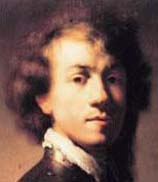 |
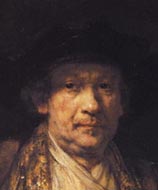 |
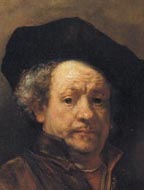 |
|
37.9 x 28.9 cm (10 cm=1 in), The Hague |
The Frick Collection |
1660, 81x67.6 cm, The Metropolitan Museum of Art, New York |
![]() None of these
elements are evident in the version in Nuremberg. There are no individual
strands of hair or bunches of frizzy locks behind, but only vaguely described
and mechanically repeated symmetrical, decorative curls. The transition to the
shadow has been softened and does not form a contour at all, the chin is not
pointed and the nose is not knobby. The shadow itself was too dark, so the
copyist went over the right cheek and the neck below with thin strokes of white
paint, which flatten the face even more. The figure now appears appear as if he
had been in a fight, the right side of his face bruised, his right eye swollen.
The right eye is in any case barely visible, and does not appear to stare at the
viewer. The copyist was not recording himself looking at himself but merely
repeating an existing composition, and with great difficulty, rather than "ease
and spontaneity." It is not Hague painting, which is one of the few reliable
records we possess regarding Rembrandt's appearance, but the Nuremberg version
that diminishes the resemblance to Rembrandt's features by making the face more
squat and widening the space between the eyes. Along with specific details, the
plasticity of the face and costume have been sacrificed, as well as the
distinctive pose. The figure does not appear to turn out to us or look down from
above but is flattened out at the center of a two-dimensional composition. As
the curators themselves admit,
None of these
elements are evident in the version in Nuremberg. There are no individual
strands of hair or bunches of frizzy locks behind, but only vaguely described
and mechanically repeated symmetrical, decorative curls. The transition to the
shadow has been softened and does not form a contour at all, the chin is not
pointed and the nose is not knobby. The shadow itself was too dark, so the
copyist went over the right cheek and the neck below with thin strokes of white
paint, which flatten the face even more. The figure now appears appear as if he
had been in a fight, the right side of his face bruised, his right eye swollen.
The right eye is in any case barely visible, and does not appear to stare at the
viewer. The copyist was not recording himself looking at himself but merely
repeating an existing composition, and with great difficulty, rather than "ease
and spontaneity." It is not Hague painting, which is one of the few reliable
records we possess regarding Rembrandt's appearance, but the Nuremberg version
that diminishes the resemblance to Rembrandt's features by making the face more
squat and widening the space between the eyes. Along with specific details, the
plasticity of the face and costume have been sacrificed, as well as the
distinctive pose. The figure does not appear to turn out to us or look down from
above but is flattened out at the center of a two-dimensional composition. As
the curators themselves admit,
The character is indeed expressed slightly better in the copy than in Rembrandt's original. By raising the head at a wider angle, closing the slightly parted lips of the original and replacing the wild curls with a well-groomed hairstyle, the copyist has given his portrait a distinguished air that is perfectly attuned to the aristocratic soldier.5
These observations are correct, only Rembrandt was the one who depicted himself as an aristocratic soldier, a young prince among painters. The student-copyist following his example was more of a foot-soldier, whose derivative "self-portrait" conveys uncertainty, a lack of distinction, and anonymity.
Self-Portrait with a Poodle
|
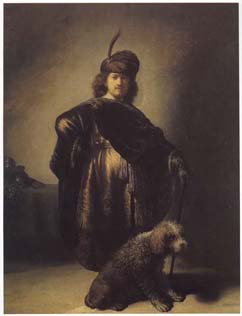 |
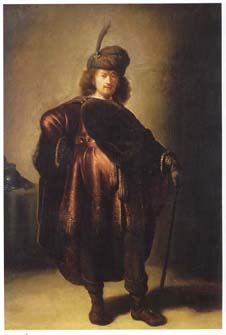 |
|
|
|
![]() Further
evidence for this conclusion is provided by another pair of paintings that were
included in the exhibition, in which the relation of original and copy is not in
doubt. Rembrandt's Self-Portrait as an Oriental in Paris was copied by a
student in a painting now in the Rembrandthuis, Amsterdam (Figs.6 and 7). In
this case as well, Rembrandt's original is executed with a meticulous painting
technique, rendering his distinctive frizzy hair, cleft chin, and staring right
eye, as well as the intricate detail and plasticity of the turban, velvet cloak
with metal clasps, and embroidered silk robe. As in the case of the Nuremberg
painting, the copyist summarizes, softens, or dulls these elements, in a largely
two-dimensional composition.The copy in Amsterdam has long been attributed to
Rembrandt's second pupil in Leiden, Isaac Jouderville, Unlike Dou, who quickly
began to paint his own peculiarly static genre subjects, Jouderville continued
to copy and vary Rembrandt's compositions for several years, focusing on
single-figures and portraits, including what seem to be variations on
Rembrandt's self-portraits even though thet depict women. in particular.
Jouderville is therefore the most logical candidate for the author of the
Nuremberg painting.
Further
evidence for this conclusion is provided by another pair of paintings that were
included in the exhibition, in which the relation of original and copy is not in
doubt. Rembrandt's Self-Portrait as an Oriental in Paris was copied by a
student in a painting now in the Rembrandthuis, Amsterdam (Figs.6 and 7). In
this case as well, Rembrandt's original is executed with a meticulous painting
technique, rendering his distinctive frizzy hair, cleft chin, and staring right
eye, as well as the intricate detail and plasticity of the turban, velvet cloak
with metal clasps, and embroidered silk robe. As in the case of the Nuremberg
painting, the copyist summarizes, softens, or dulls these elements, in a largely
two-dimensional composition.The copy in Amsterdam has long been attributed to
Rembrandt's second pupil in Leiden, Isaac Jouderville, Unlike Dou, who quickly
began to paint his own peculiarly static genre subjects, Jouderville continued
to copy and vary Rembrandt's compositions for several years, focusing on
single-figures and portraits, including what seem to be variations on
Rembrandt's self-portraits even though thet depict women. in particular.
Jouderville is therefore the most logical candidate for the author of the
Nuremberg painting.![]() A particularly interesting detail is the absence of the poodle. X-rays
reveal that this was not included at first in Rembrandt's original. The curators
claim that "this is the only occasion on which Rembrandt painted a full-length
portrait of himself" and propose that "he found it no easy task," although they
assume the dog was "an afterthought" made several years later. Rather, Rembrandt already portrayed himself as a full-length figure without
apparent difficulty in his Artist in the Studio in Boston, which was also
included in the exhibition. I would propose another explanation for the
addition. After Rembrandt saw his student's copy, which renders the feet in a
dull, flat, awkward manner, and too close to the edge of the panel, undermining
the spatial dimensions of the scene, he decided to underscore the depth of his
own composition by employing the poodle as a space-creating repoussoir.
The motif further underscores the distinction between his original and the
student copy, specifically through an animal whose subtly rendered, complex hair
was presumably beyond the technical capacities of the student to reproduce. The
poodle is not simply an aristocratic attribute of an oriental potentate or
prince but embodies Rembrandt's skill and originality. The dog even echoes
Rembrandt's appearance, as is often said of pets and their owners, with its
shaggy locks and top-heavy main of hair over its shaved lower body, paralleling
Rembrandt's velvet cloak and leggings. Rembrandt's Self-Portrait as an
Oriental not only emphatically identifies itself as "the original" but can
also serve as a means to recognize Rembrandt's other originals. He conceivably
had such a purpose in mind in relation to his prior self-portrait and its copy,
which could have already been mistaken for the original in his time, as it
recently was. Rembrandt's students copying his example thus stimulated his
originality and forced him to define his artistic self or personality in
increasingly explicit terms.
A particularly interesting detail is the absence of the poodle. X-rays
reveal that this was not included at first in Rembrandt's original. The curators
claim that "this is the only occasion on which Rembrandt painted a full-length
portrait of himself" and propose that "he found it no easy task," although they
assume the dog was "an afterthought" made several years later. Rather, Rembrandt already portrayed himself as a full-length figure without
apparent difficulty in his Artist in the Studio in Boston, which was also
included in the exhibition. I would propose another explanation for the
addition. After Rembrandt saw his student's copy, which renders the feet in a
dull, flat, awkward manner, and too close to the edge of the panel, undermining
the spatial dimensions of the scene, he decided to underscore the depth of his
own composition by employing the poodle as a space-creating repoussoir.
The motif further underscores the distinction between his original and the
student copy, specifically through an animal whose subtly rendered, complex hair
was presumably beyond the technical capacities of the student to reproduce. The
poodle is not simply an aristocratic attribute of an oriental potentate or
prince but embodies Rembrandt's skill and originality. The dog even echoes
Rembrandt's appearance, as is often said of pets and their owners, with its
shaggy locks and top-heavy main of hair over its shaved lower body, paralleling
Rembrandt's velvet cloak and leggings. Rembrandt's Self-Portrait as an
Oriental not only emphatically identifies itself as "the original" but can
also serve as a means to recognize Rembrandt's other originals. He conceivably
had such a purpose in mind in relation to his prior self-portrait and its copy,
which could have already been mistaken for the original in his time, as it
recently was. Rembrandt's students copying his example thus stimulated his
originality and forced him to define his artistic self or personality in
increasingly explicit terms.